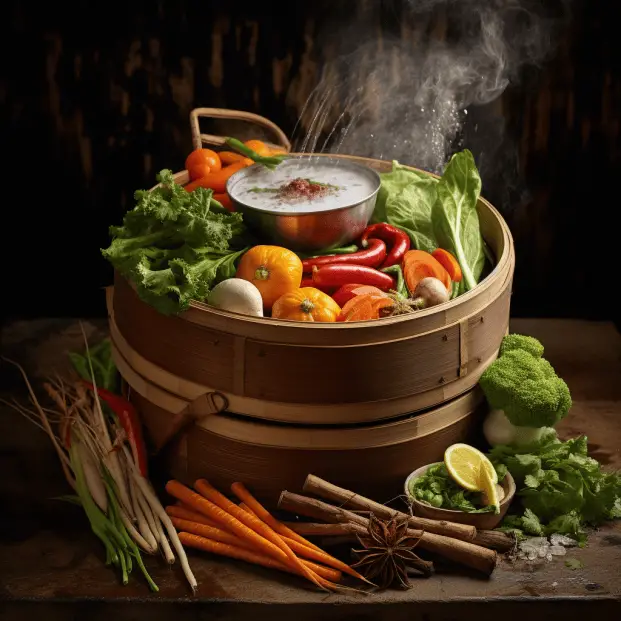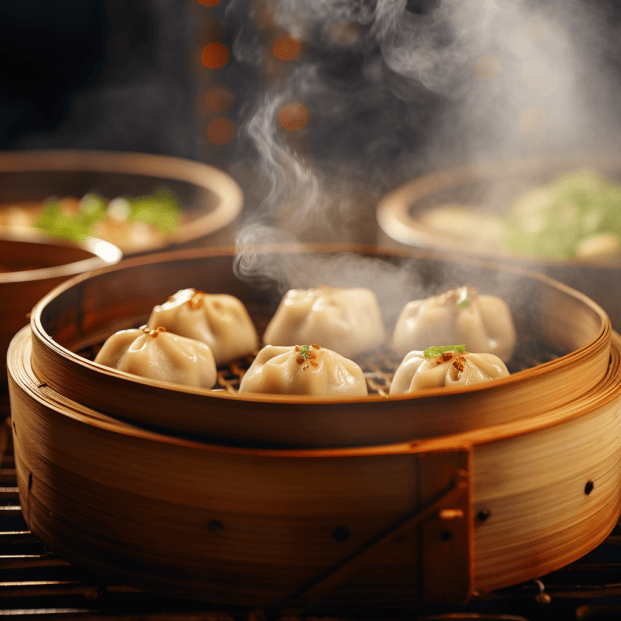What exactly is steaming and how does it work its magic on foods?
Steaming may seem like a simple cooking technique, but there’s some neat science involved in transforming raw ingredients into delicious dishes.
As an avid home cook and steaming enthusiast, I’m excited to walk you through the ins and outs of different steaming methods.
You’ll learn the basic steaming process, the unique benefits it provides, and how to choose the best techniques for different foods.
Get ready for a deep dive into the moist, flavorful world of steaming! I’ll explain the way steam’s heat tenderizes meals to perfection.
You’ll be amazed at how a little hot vapor can take your cooking abilities to the next level.
Let’s unlock the secrets of splendidly steamed suppers!
KEY TAKEAWAY
What is the method of steaming?
The method of steaming involves cooking food using hot vapor, which is created by boiling water underneath the food. (1)
This gentle and moist cooking technique helps retain the food’s nutrients and flavors while maintaining its natural texture.
Understanding Steaming as a Culinary Technique
Steaming is a moist-heat cooking method that uses hot steam to gently cook foods.
Unlike boiling or sautéing, steaming does not require directly immersing food in water or oil.
With steaming, food is suspended above simmering water, allowing steam vapor to surround and infuse ingredients.
A tight-fitting lid is key, as it traps the steam close to the food.
This steam cannot escape, so it continually heats and tenderizes the ingredients.
The food cooks through gentle, even contact with the moist steam heat reaching 212°F (100°C).
A major benefit is that natural juices and flavors are locked in since steam cooking provides moist heat without leaching liquids like boiling does.
Overall, steaming produces dishes with light, tender textures, and bright, fresh flavors.
The ingredients’ moisture and essence are perfectly preserved.
Understanding these steaming basics allows you to tailor equipment and methods to different foods.
Now let’s explore all the wonderful benefits steaming offers!
Benefits and Advantages of Steaming

Steaming provides many advantages compared to other moist cooking techniques. (2)
The gentle heat thoroughly cooks ingredients while retaining more vitamins and nutrients that can be lost in aggressive boiling.
Subtle flavors shine through rather than being masked under heavy sauces.
Texture is beautifully preserved – ingredients remain tender with a pleasant bite rather than becoming mushy.
The moist environment steams fragile foods like fish, dumplings, and vegetables perfectly without overcooking exteriors.
Vibrant colors are enhanced for attractive plated presentations.
Minimal preparation and cleanup are needed, since there is only a small amount of condensed liquid after steaming.
It also offers great versatility to quickly cook entire meals simultaneously by steaming components like proteins, vegetables, and grains in layers.
Steaming works wonderfully across many cuisines, from Asian favorites to American comfort foods.
Understanding these many perks allows you to utilize steaming for all kinds of delicious, healthy dishes!
Exploring Different Steaming Equipment and Tools

Harnessing hot steam’s powers deliriously enhancing any ingredients demands fitting conduits delivering humid heat precisely.
Being an avid home cook experimenting with Asian to European delights, diverse vessels prove worthwhile exploring the technique’s realm expansively:
For starters, simple gear like bamboo or stainless-steel steaming baskets nesting over saucepans suits cooking most meals swiftly in one pot.
Suspending ingredients atop boiling cooking liquid steams tender morsels wraps sealed.
Moveable expandable colanders and stacking steamer inserts maximize production preparing multiple portions simultaneously within one pot.
Elevating foods permits steam surrounding without touching the water below.
Specialized electric steamers gain popularity now, cooking multiple tiers of nourishments automatically by time as kitchens stay mess-free.
Set programming finishes cooking perfectly tailored particular recipes’ requirements.
Even conventional pots take steaming dishes creatively! Perforating lids transforms standard saucepans.
Metal colanders placed inside pots likewise add layering.Whist steam rises, flavors permeate delectably anything settled rim above.
Traditions like Southeast Asia’s woven bamboo steamers and Latin America’s banana leaves prove steaming arts existed for millenniums, imparting subtle signatures any home chef blesses the global table astonishingly!
How to Steam Food: Techniques and Methods
Mastering steaming grants versatility enhancing any repast delightfully unique.
As an experienced home cook, here are principles for bringing out each ingredient’s best:
- Add just enough boiling cooking liquid like water, stock or wine covering the pan bottom before arranging foods on elevated racks above.
- For quicker steaming modulate heat high, while slower steaming uses mid-high bringing mixtures to a boil and then reducing heat. Adjust burners to suit the recipe.
- Stack creatively maximizing capacity within pots varied or specialized steamers. Interleave with parchment avoiding sticking.
- Monitor doneness closely with instant-read thermometers for meats and poultry. Test vegetables tenderly with forks.
- Release steam protecting hands before lifting lids away from the watcher to avoid sudden burns.
- Consider natural wrappers like banana leaves or grape leaves parceling seafood, vegetables, and luscious dishes steaming aromatically.
- Finish with sauces, dressings orserving immediately while hot and refreshing!
Steaming graces any table wonderfully once fundamental methods are put in practice creatively.
Steaming vs. Boiling: Which is Better for Vegetables?
Evaluating preparation techniques, steaming proves more nutritious for beloved greens and roots versus submerging boiling waters.
As an enthusiastic home cook, experience steams significant gains retaining nutrients largely unrivaled compared other methods:
During steaming, food items are suspended over – not within – simmering liquid delivering heat gently through water vapor.
This preserves nutrients water-soluble which boiling fully extracts abandoning flavor and minerals down the drain.
Moreover, steaming maintains the integrity of cellular structures failing integrity once boiled soft.
Steamed foods retain vibrant color, and supreme texture another cooking process destroys.
Flavor also strengthens with heat penetrating succulently fibers and skins cradling sapor intactly.
Boiling leaches liquids in food diluting concentration deliciousness steaming locks interiorly.
Overcooking dulls or toughens results where moderate steaming halts just before complete tenderness perfectly al dente.
Overall steaming excels in healthfulness when applied cunningly to fit each steamed dish.
Controlled humid cooking by time unlocks vegetables’ and gains nutritional fully without compromising flavors remarkably making this often underrated technique the most beauteous method of gracing a table with mastery.
Tips for Safe and Effective Steaming
Mastery steaming demands nuanced understanding both equipment and principles:
Fill pots generating steam just inches of water high preventing overflows while cooking above humid heat source.
Elevate foods elevated atop pot bottom extending their contact time with steam penetrating thoroughly without waterlogging.
Steam in batches avoiding overcrowding vessels permitting circulation saturating items moistly and evenly.
Monitor doneness tending pots maintaining simmering hot water without boiling dry causing damage inefficiently.
Choose containers like bamboo steamer baskets or bowls microwave-safe fit vessel rimming rim easily above maintaining connection steam rising circulation.
Patience factors greatly allowing heat to penetrate gently fibers without sacrificing textures.
Stack intelligently maximizing capacity within limited real estate in Asian cuisines utilizing tiered stackable steam setups adeptly.
Steam only what may be consumed freshly for for peak flavor and nutrition retention shortly served hot
Overall mastery of steaming extracts cuisines’ most gratifying qualities with nuance just as water’s vapor works subtly yet profoundly enhancing any ingredient’s gifts deliciously.
Steaming Beyond Vegetables: Diverse Food Options
While greens often captivate thoughts upon steaming, this technique transcends bringing delectable varieties to tables simply through humidity’s deft and subtle touch.
From fishing wharfs to patisseries worldwide, consider broadening steaming horizons magnificently:
Meats like chicken, seafood and tender cuts pork exit pots silken within minutes surrounded by vapors penetrating deeply without drying or shrinking textures.
Seasonings throughout cooking permeate morsels with flavor intensely despite bare contact heat source minimal yet effective.
One-dish steaming betsuffy as tray bakes, casseroles, stuffed vegetables and breads flow easily from oven to stovetop atop liquid in covered pans.
Aromatics mingling through moist cooking emerge bright without regards fussy techniques.
Sweets find new life steaming without risk of burning sugars.
Puddings, custards and formal desserts are prepared in bowls lined delicate sheets of aluminum foil emerging smooth and light.
Evaporated through paper eliminates calorie fusses.
Root vegetables, potatoes, and tamales wrapped cleverly in parchment or aromatic leaf steaming in bundles permitting natural juices bathing morsels to succulent doneness without waterlogging risk.
Overall thinking beyond steam’s usual realms expands any cook’s skills fitting diverse cultures magnificently onto plates beautifully simple yet profoundly enhanced through humidity’s gifts showering ingredients gloriously from foundational techniques!
History and Cultural Significance of Steaming
While convenience lures modern cooks, humid cooking roots run deep signifying nourishing ancient traditions worldwide.
As an avidity student of culinary histories, consider the richness imparted civilizations globally:
In Asia, steaming emerged likely millennia ago as a way of preparation accommodating varied weather, and lifestyles conveniently without fuss fuels finding.
Cooking baskets ubiquitous in signature cuisine’s refined sophisticated techniques or rushed schedules.
For indigenous Latin America, steamed tamales leaf-wrapped remain a sacrament uniting families during harvests honoring ancestors whose traditions live fruitfully generations later.
Throughout Africa, steaming sustains community events feeding multitudes amid challenges equitably without excess accoutrements focused nutrition.
Heritage foods maintain identities across turbulences.
Even European aristocracy elevated steaming subtly1800s as dining delicacies emerged refined genteel method preparations graced tables esteeming wealth leisure displaying cultivated tastes.
Beyond history, steaming impacts environments preserving voracious appetites moderating consumption amid planet’s rapid changes in climate compounding daily threats to biodiversity supporting centuries ahead too through sustainable cultural sensitivity!
Conclusion
Now that you’re a steaming expert, you have all the know-how to cook up incredibly tasty steamed meals at home.
Remember, the key is controlling steam’s heat and moisture to cook foods without overdoing it.
I hope this guide has illuminated the science behind steaming and how to best take advantage of it in your kitchen.
The world of perfectly steamed, succulent dishes is at your fingertips!
For more useful cooking tips and tricks, be sure to check out my articles on getting the most juice out of citrus fruits and slicing onions without tears.
And as always, please reach out if you have any other food science curiosities – I love helping decode kitchen mysteries!
If you want to know how to steam without steamer, read more tips on the article here.
References
- https://asiasociety.org/education/science-steaming#:~:text=Steaming%20is%20a%20method%20of,direct%20contact%20with%20the%20team.
- https://www.healthshots.com/healthy-eating/nutrition/benefits-of-steam-cooking-your-food-for-weight-loss-and-more/#:~:text=Keeps%20the%20vitamins%20and%20minerals%20intact&text=The%20process%20of%20steaming%20retains,phosphorous%2C%20and%20zinc%20remain%20intact.
Related Articles
- https://bowlakechinese.com/low-sodium-chinese-food-products/
- https://bowlakechinese.com/steaming/
- https://bowlakechinese.com/how-do-you-steam-without-a-steamer/
Was this helpful?

I am a skilled chef assistant with a passion for Asian cuisine, I have honed my craft through formal training at At-Sunrice GlobalChef Academy and years of experience in the culinary industry. I have extensive knowledge of cooking techniques and herbs and spices, with a particular focus on traditional Chinese dishes. I’m also an author of the book “Delicious Keto Low Carb Chinese Food for Busy Moms and Fitness Enthusiasts” which is sold on Amazon. On my blog, bowlakechinese.com, I share my expertise in Asian cuisine and provide tips and recipes for those interested in low carb Chinese cuisine.

